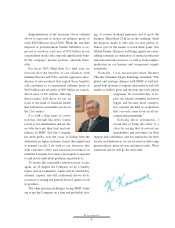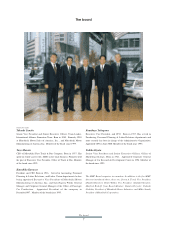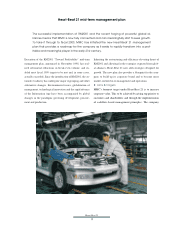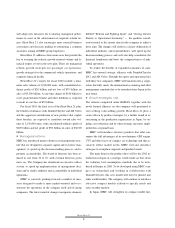Mitsubishi 2000 Annual Report Download - page 17
Download and view the complete annual report
Please find page 17 of the 2000 Mitsubishi annual report below. You can navigate through the pages in the report by either clicking on the pages listed below, or by using the keyword search tool below to find specific information within the annual report.
On the analyst's couch: 2000
15
right on schedule in terms of cutting payroll and produc-
tion capacity, and of reducing debt. From a target per-
spective, then, I can say we have achieved a high degree
of success in executing the programs dictated by
RM2001.
This, however, makes it all the more vexing and re-
grettable that we should have failed to meet our financial
targets: posting an acceptable level of profit and restoring
dividend payment. You can be assured, however, that we
will be going the full nine yards do so with Heart-Beat
21, our new mid-term management plan. We are also
making progress in trimming the product lineup and are
being very decisive about this.
S: Lowering operating costs is obviously an important tar-
get for you. Are you considering any further integration
of platforms?
K: Our first step has been to integrate our minicar, RV and
sedan platforms, so that today around 70 percent of mod-
els share floor pans. When suppliers are included in the
equation, this integration of platforms has not produced
the economic benefits we expected; basically because
overall production volumes are small. But, this is an vital
area for us to focus on. I am hoping the integration of our
minicar platforms trigger greater efforts in that direction.
A shared platform also provides the opportunity to make
more use of common parts, and we will also be able to
use it in the Z-Car.
Now, we have yet to officially announce this and so I
do not want to make too much of it but we are currently
producing 500,000 units a year from one single platform
and the forecast is that this might well increase to
700,000. MMC has never developed anything that has
been produced in such numbers so I'm looking to make
the most of the opportunities this presents.
U: Would you please tell us something about your collabo-
rative ties in Asia?
K: We currently enjoy a number of tie ups in S.E. Asia.
With all of them, we have adopted the stance of extend-
ing assistance by doing all we can to raise the technologi-
cal capabilities of our partners. In our alliance with the
national enterprise Proton in Malaysia, we are helping
the country to achieve its aim of raising its capabilities to
the level of an advanced country by the year 2002.
U: The Asian economy is showing signs of recovery but
what about the auto markets in the region?
K: The situation differs from country to country. In
Indonesia, the market is growing again at a fantastic rate:
somewhere between 400% and 800% and so we are natu-
rally very hopeful about prospects there. The market in
Thailand has recovered somewhat but may peak soon.
It's pretty much business as usual in Taiwan, while there
has been no substantial recovery yet in the Philippines. I
will not deny the possibility of working together with
DaimlerChrysler in Korea and China; there are many ar-
eas where we can support each other in those markets.
But China requires special care, and we are waiting to
see what happens, waiting for the right moment.
H: Would you tell us something about Project America?
K: My view is that our projects in the United States over the
years have been somewhat lacking in terms of the total
Katsuhiko Kawasoe
























